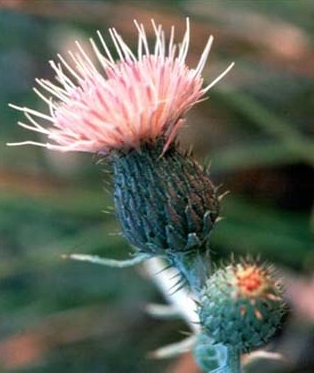By KIMBERLY HIRAI
Capital News Service
LANSING — What botanists might consider the fairest may be the rarest in Michigan.

Pitcher's thistle is one of more than 400 native flowering plants on a list of threatened species in Michigan. Credit: U.S. Fish and Wildlife Service.
Flowering plants top a list of extremely rare species groups in an analysis of endangered, threatened, extinct and special concern animal and plant species.
They outnumber similar species in mammal, amphibian, reptile, fern and other groups by nearly two to one.
But what’s rare in Michigan may be more common elsewhere.
“The vast majority of our flora is decidedly common outside Michigan,” said Michael Penskar, the lead botanist for the Michigan Natural Resources Inventory, a group that tracks rare species.
Michigan contains the edges of larger populations of plants that aren’t exclusive to the state — much of their population may be in neighboring states where those plants don’t even make the rare species list.
Penskar said there are more plant species on the inventory’s list because there are more plant than animal species. Michigan supports 2,700 to 2,800 plant species, and more than 400 of its 1,800 native flowering plants are on the list.
“So if you have more to begin with, you’re going to have more that will be affected by human settlement and the like,” Penskar said. “We should be concerned about what’s rare in our state regardless of if it’s very common…because that mix of species is part of our natural heritage,” Penskar said.
Those facing extinction tend to be the most finicky, like the Michigan monkey-flower – “the rarest of the rare for Michigan,” Penskar said.
A perennial with tubular yellow flowers, the monkey-flower is found only in 12 isolated populations throughout Michigan. Penskar penned the monkey-flower’s 1997 recovery plan after it obtained endangered species designation in 1990.
The plant is endemic — it has a narrow, specific range that includes the Straits of Mackinac and Grand Traverse regions, according to the U.S. Fish and Wildlife Service.
But the monkey-flower remains rare in Michigan because it’s picky — it likes sticky, sandy soils near streams and lakes. All known populations are associated with the Great Lakes shorelines. There, the monkey-flower likes only cold, flowing spring water.
But with such specific needs, the monkey-flower’s greatest threat is habitat destruction and conversion. Off-road vehicles turn up the soil and destroy habitat. The lure of lakefront property also leaves the monkey-flower in the dust as development progresses.
Habitat destruction along shorelines is also a problem for Hall’s bulrush, found in coastal plain marshes that are not common in southwest Michigan, northern Indiana and part of Illinois.
Off-roading activity often increases when waters recede and create muddy conditions in its habitat, said Brad Slaughter, an inventory botany conservation associate. “They look really ugly and scarred when that happens, especially when they’re wet and you just end up with huge wheel ruts.”
Hall’s bulrush prefers its own specialized pad, and Penskar warned that the bulrush could become the new monkey-flower in Michigan.
The marsh type it prefers is also specialized—it’s characterized by draw-down lakes or ponds, Slaughter said.
“Usually in the late winter, early spring it looks like a lake or a pond but by the end of summer there’s no inlet or outlet to these systems. They’re pretty much just fed by the water table and precipitation so it’ll just draw right down and be dry,” he said.
Some sites can remain dry for more than 10 years.
Hall’s bulrush can be elusive, though.
“It might not even appear above the ground until conditions are right,” Slaughter said.
Instead, Hall’s bulrush remains in a seed state. Slaughter said bulrush was last sighted in Michigan in 2002 and suddenly reappeared in 2008-2009.
Changes in groundwater or precipitation due to climate change could also spell trouble for the bulrush.
Not all stories end with extinction. Recovery plans for Pitcher’s thistle were completed in 2002, though efforts to save the dune dweller began before then, said Tameka Dandridge, an East Lansing-based U.S. Fish and Wildlife Service wildlife biologist who works on recovery plans.
There are many populations of the thistle in Michigan, Indiana, Wisconsin and Ontario, but Pitcher’s thistle is found only on shorelines or Great Lakes sand dunes.
Dandridge said the fragmented locations of populations make monitoring key to ensuring they don’t disappear. Habitat destruction by off-road vehicles and invasive species threaten the species too.
The thistle doesn’t produce seeds for more than five to 10 years. The seed is large and typically lands near the parent plant because it can’t travel on wind.
It could soon be removed from the rare species list based on continuing recovery plans, better landowner awareness of the plant’s needs, discovery of new populations and assessment of old ones, Dandridge said.
But Slaughter said the situation isn’t ideal.
“It’s a bad sign for the environment,” he said, referring to all rare plant species in the state. “They’re so degraded and fragmented that if we do nothing, they’ll just go away. Even if we do something we might just buy them more time.
Kimberly Hirai writes for Great Lakes Echo